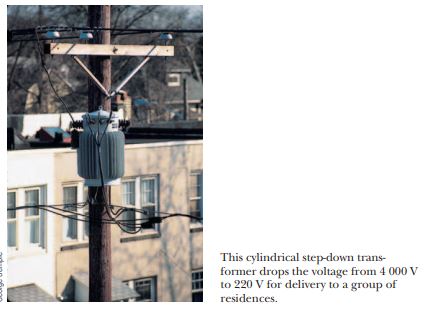Question 21.7: Distributing Power to a City Goal Understand transformers an...
Distributing Power to a City
Goal Understand transformers and their role in reducing power loss.
Problem A generator at a utility company produces 1.00 \times 10^{2} \mathrm{~A} of current at 4.00 \times 10^{3} \mathrm{~V}. The voltage is stepped up to 2.40 \times 10^{5} \mathrm{~V} by a transformer before being sent on a high-voltage transmission line across a rural area to a city. Assume that the effective resistance of the power line is 30.0 \Omega and that the transformers are ideal. (a) Determine the percentage of power lost in the transmission line. (b) What percentage of the original power would be lost in the transmission line if the voltage were not stepped up?
Strategy Solving this problem is just a matter of substitution into the equation for transformers and the equation for power loss. To obtain the fraction of power lost, it’s also necessary to compute the power output of the generatorthe current times the potential difference created by the generator.
Learn more on how we answer questions.
(a) Determine the percentage of power lost in the line.
Substitute into Equation 21.23
I_{1}\,\Delta\,V_{1}=I_{2}\,\Delta\,V_{2} (21.23)
to find the current in the transmission line:
I_{2}=\frac{I_{1} \Delta V_{1}}{\Delta V_{2}}=\frac{\left(1.00 \times 10^{2} \mathrm{~A}\right)\left(4.00 \times 10^{3} \mathrm{~V}\right)}{2.40 \times 10^{5} \mathrm{~V}}=1.67 \mathrm{~A}
Now use Equation 21.16
\mathscr{P}_{\mathrm{av}}=I_{\mathrm{rms}}^{2}R (21.16)
to find the power lost in the transmission line:
\text { (1) } \mathscr{P}_{\text {lost }}=I_{2}{ }^{2} R=(1.67 \mathrm{~A})^{2}(30.0 \Omega)=83.7 \mathrm{~W}
Calculate the power output of the generator:
\mathscr{P}=I_{1} \Delta V_{1}=\left(1.00 \times 10^{2} \mathrm{~A}\right)\left(4.00 \times 10^{3} \mathrm{~V}\right)=4.00 \times 10^{5} \mathrm{~W}
Finally, divide \mathscr{P}_{\text {lost }} by the power output and multiply by 100 to find the percentage of power lost:
\% \text { power lost }=\left(\frac{83.7 \mathrm{~W}}{4.00 \times 10^{5} \mathrm{~W}}\right) \times 100=0.0209 \%
(b) What percentage of the original power would be lost in the transmission line if the voltage were not stepped up?
Replace the stepped-up current in equation (1) by the original current of 1.00 \times 10^{2} \mathrm{~A}.
\mathscr{P}_{\text {lost }}=I^{2} R=\left(1.00 \times 10^{2} \mathrm{~A}\right)^{2}(30.0 \Omega)=3.00 \times 10^{5} \mathrm{~W}
Calculate the percentage loss, as before:
\% \text { power lost }=\left(\frac{3.00 \times 10^{5} \mathrm{~W}}{4.00 \times 10^{5} \mathrm{~W}}\right) \times 100=75 \%
Remarks This example illustrates the advantage of high-voltage transmission lines. At the city, a transformer at a substation steps the voltage back down to about 4000 \mathrm{~V}, and this voltage is maintained across utility lines throughout the city. When the power is to be used at a home or business, a transformer on a utility pole near the establishment reduces the voltage to 240 \mathrm{~V} or 120 \mathrm{~V}.
